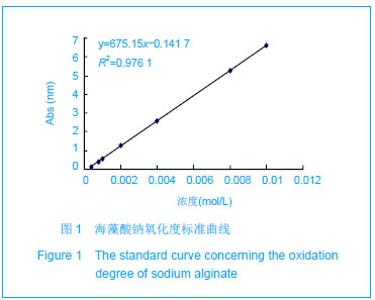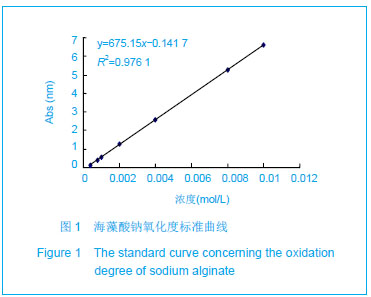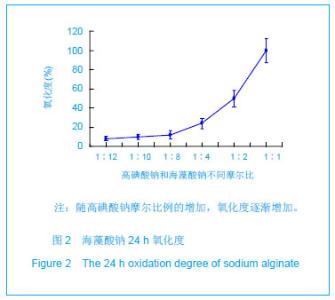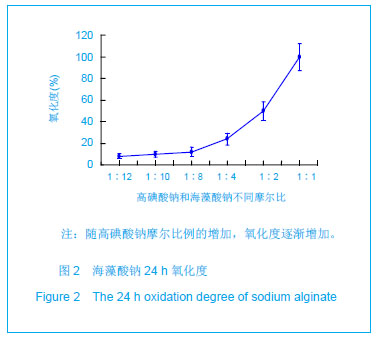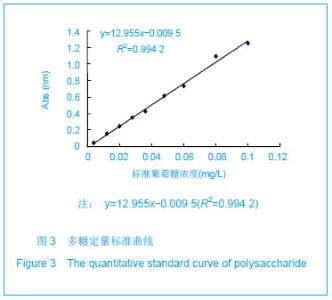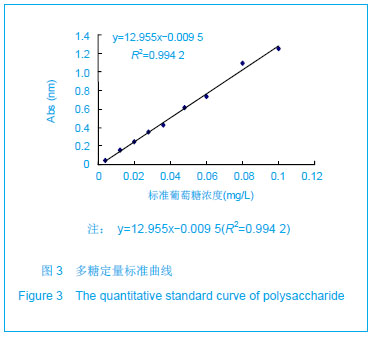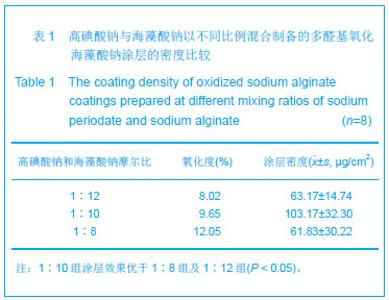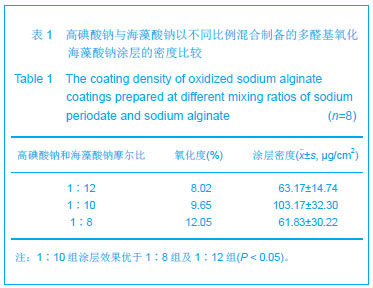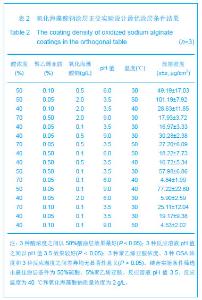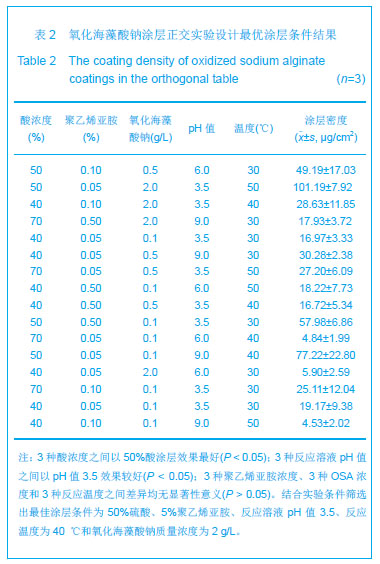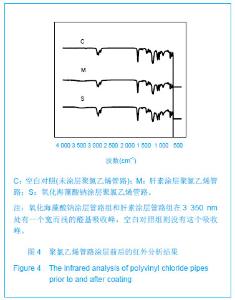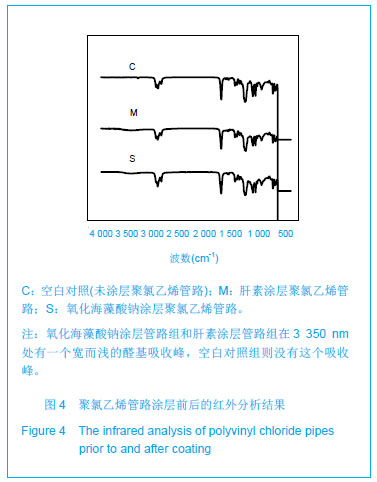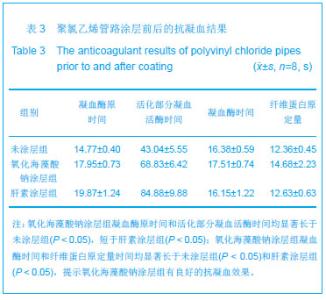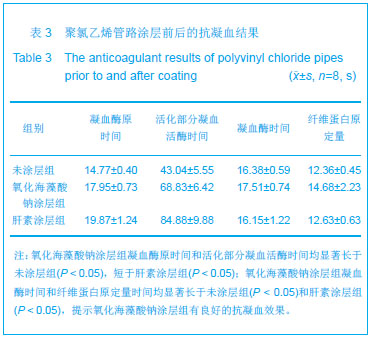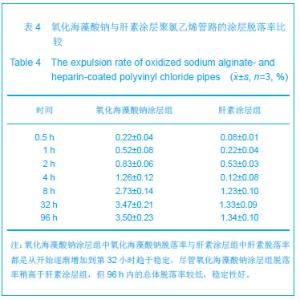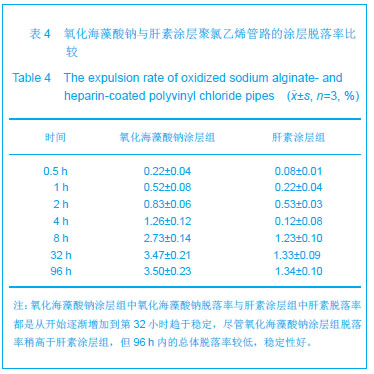Chinese Journal of Tissue Engineering Research ›› 2013, Vol. 17 ›› Issue (34): 6159-6165.doi: 10.3969/j.issn.2095-4344.2013.34.015
Previous Articles Next Articles
Oxidized sodium alginate used in an extracorporeal circulation pipe
Li Jin-you1, Li Tong2, Yu Mei-li3, Gao Wen-qing2, Hu Xiao-min2, Lu Hai-bin1, Yu Guang-dong1
- 1Postgraduate School of Tianjin Medical University, Tianjin 300170, China; 2the Third Central Hospital of Tianjin, Tianjin 300170, China; 3Key Laboratory of Artificial Cells, Tianjin 300170, China
-
Online:2013-08-20Published:2013-08-20 -
Contact:Li Tong, Professor, the Third Central Hospital of Tianjin, Tianjin 300170, China litongtj@163.com -
About author:Li Jin-you, Studying for master’s degree, Postgraduate School of Tianjin Medical University, Tianjin 300170, China xuhuanzenren@163.com -
Supported by:the Scientific and Technological Program of Tianjin, No. 11ZCGYSY02000*; the General Program of Tianjin Municipal Science and Technology Commission, No. 09JCYBJC27600*
CLC Number:
Cite this article
Li Jin-you, Li Tong, Yu Mei-li, Gao Wen-qing, Hu Xiao-min, Lu Hai-bin, Yu Guang-dong. Oxidized sodium alginate used in an extracorporeal circulation pipe[J]. Chinese Journal of Tissue Engineering Research, 2013, 17(34): 6159-6165.
share this article
| [1]Thiara AS,Andersen VY,Videm V,et al. Comparable biocompatibility of Phisio- and Bioline-coated cardiopulmonary bypass circuits indicated by the inflammatory response. Perfusion.2010;25(1):9-16.[2]Gunaydin S,Farsak B,McCusker K, et al. Clinical and biomaterial evaluation of hyaluronan-based heparin-bonded extracorporeal circuits with reduced versus full systemic anticoagulation in reoperation for coronary revascularization. Cardiovasc Med (Hagerstown).2009;10(2):135-142.[3]Luo P,Liu W,Yang C,et al. Preparation and antithrombogenicity of oxidated low molecular weight heparin- antithrombin complex coated-polyvinyl chloride tubing.Sheng Wu Yi Xue Gong Cheng Xue Za Zhi.2011;28(1):90-94.[4]Larm O,Larsson R,Olsson P.A new non-thrombogenic surface prepared by selective covalent binding of heparin via a modified reducing terminal residue. Biomater Med Devices Artif Organs.1983;11(2-3):161-234.[5]Nozohoor S,Johnsson P,Scicluna S,et al. A case-controlled evaluation of the Medtronic Resting Heart System compared with conventional cardiopulmonary bypass in patients undergoing isolated coronary artery bypass surgery. Interact Cardiovasc Thorac Surg.2012;14(5):599-604.[6]Mahmood S,Bilal H,Zaman M,et al.Is a fully heparin-bonded cardiopulmonary bypass circuit superior to a standard cardiopulmonary bypass circuit? Interact Cardiovasc Thorac Surg.2012;14(4):406-414.[7]Moreno I,Soria A,López Gómez A,et al.Extracorporeal membrane oxygenation after cardiac surgery in 12 patients with cardiogenic shock. Rev Esp Anestesiol Reanim.2011;58(3):156-160.[8]Hsu KH,Chi NH,Yu HY,et al. Extracorporeal membranous oxygenation support for acute fulminant myocarditis:analysis of a single center's experience. Cardiothorac Surg.2011;40(3): 682-688.[9]Riscili BP,Anderson TB,Prescott HC,et al.An assessment of H1N1 influenza-associated acute respiratory distress syndrome severity after adjustment for treatment characteristics. PLoS One.2011; 6(3): e18166.[10]Nishino T,Yokoyama G,Dobashi K,et al.Isolation, purification, and characterization of fucose-containing sulfated polysaccharides from the brown seaweed Ecklonia kurome and their blood-anticoagulant activities. Carbohydr Res.1989;186(1):119-148.[11]Arora S,Budhiraja RD. Chitosan-alginate microcapsules of amoxicillin for gastric stability and mucoadhesion. Adv Pharm Technol Res. 2012;3(1):68-74.[12]Del Gaudio P,Russo P,Rosaria Lauro M,et al. Encapsulation of ketoprofen and ketoprofen lysinate by prilling for controlled drug release.AAPS PharmSciTech.2009;10(4):1178-1185.[13]Barnett BP,Arepally A,Stuber M,et al.Synthesis of magnetic resonance-,X-ray-and ultrasound-visible alginate microcapsules for immunoisolation and noninvasive imaging of cellular therapeutics.Nat Protoc.2011;6(8):1142-1151.[14]Park SJ,Shin S,Koo OJ,et al.Functional improvement of porcine neonatal pancreatic cell clusters via conformal encapsulation using an air-driven encapsulator.Exp Mol Med. 2012;1(44):20-25.[15]Shao S,Gao Y,Xie B,et al.Correction of hyperglycemia in type 1 diabetic models by transplantation of encapsulated insulin-producing cells derived from mouse embryo progenitor. J Endocrinol. 2011(208):245-255.[16]高长路,刘颖新,武林枫.微囊化甲状旁腺细胞移植的研究进展[J]. 黑龙江医学, 2009,2(2):115-119.[17]Sapir Y,Cohen S,Friedman G,et al.The promotion of in vitro vessel-like organization of endothelial cells in magnetically responsive alginate scaffolds. Biomaterials.2011;33(16): 4100-4109. [18]Xia Y,Mei F,Duan Y,et al. Bone tissue engineering using bone marrow stromal cells and an injectable sodium alginate/gelatin scaffold.Biomed Mater Res A.2012;100(4): 1044-1050.[19]Weir MD,Xu HH.Human bone marrow stem cell-encapsulating calcium phosphate scaffolds for bone repair.Acta Biomater.2010;10(6):4118-4126.[20]Forster RE,Thürmer F,Wallrapp C, et al.Characterisation of physico-mechanical properties and degradation potential of calcium alginate beads for use in embolisation . Mater Sci Mater Med.2010;5(21):2243-2251.[21]Bouhadir KH,Lee KY,Alsberg E,et al.Degradation of partially oxidized alginate and its potential application for tissue engineering. Biotechnol Prog.2001;17(5):945-995.[22]何淑兰,张敏,耿占杰,等.部分氧化海藻酸钠的制备与性能[J].应用化学,2005,22(9):1007-1011.[23]钟方晓,任海华,李岩.多糖含量测定方法比较[J].时珍国医国药, 2007,18(8):1916-1917.[24]Gao C,Liu M,Chen J,et al.Interactions between bovine serum albumin and oxidized sodium alginate in solution.Biomater Sci Polym Ed. 2011;22(12):1639-1650.[25]梁晔,刘万顺,韩宝芹,等.一种新型生物交联剂的制备及其性质[J].中国海洋大学学报,2008,38(4) : 590-594.[26]Andersson LO,Hoffman J,Holmer E,et al.Mechanisms of anticoagulant effects of some sulphated polysaccharides. Thromb Res.1982;28(6):741-748.[27]Mirow N,Zittermann A,Koertke H,et al.Heparin-coated extracorporeal circulation in combination with low dose systemic heparinization reduces early postoperative blood loss in cardiac surgery.Cardiovasc Surg (Torino). 2008;49(2): 277-284.[28]Ovrum E,Tangen G,Tølløfsrud S,et al. Heparinized cardiopulmonary bypass circuits and low systemic anticoagulation: an analysis of nearly 6000 patients undergoing coronary artery bypass grafting. Thorac Cardiovasc Surg.2011;141(5):1145-1149. |
| [1] | Chen Zehua, Ye Xiangling, Chen Weijian, Du Jianping, Liu Wengang, Xu Xuemeng. Effect of pronated foot posture on proprioception and postural stability based on foot posture index [J]. Chinese Journal of Tissue Engineering Research, 2021, 25(9): 1324-1328. |
| [2] | Xu Yulin, Shen Shi, Zhuo Naiqiang, Yang Huilin, Yang Chao, Li Yang, Zhao Heng, Zhao Lu. Biomechanical comparison of three different plate fixation methods for acetabular posterior column fractures in standing and sitting positions [J]. Chinese Journal of Tissue Engineering Research, 2021, 25(6): 826-830. |
| [3] | Wang Jiangna, Zheng Huifen, Sun Wei. Changes in dynamic stability, motor coordination and joint mechanics of the lower extremity during stair descent and performing phone task [J]. Chinese Journal of Tissue Engineering Research, 2021, 25(6): 837-843. |
| [4] | Li Li, Ma Li. Immobilization of lactase on magnetic chitosan microspheres and its effect on enzymatic properties [J]. Chinese Journal of Tissue Engineering Research, 2021, 25(4): 576-581. |
| [5] | Shi Xiaoxiu, Mao Shilong, Liu Yang, Ma Xingshuang, Luo Yanfeng. Comparison of tantalum and titanium (alloy) as orthopedic materials: physical and chemical indexes, antibacterial and osteogenic ability [J]. Chinese Journal of Tissue Engineering Research, 2021, 25(4): 593-599. |
| [6] | Zhou Anqi, Tang Yufei, Wu Bingfeng, Xiang Lin. Designing of periosteum tissue engineering: combination of generality and individuality [J]. Chinese Journal of Tissue Engineering Research, 2021, 25(22): 3551-3557. |
| [7] | Huo Hua, Cheng Yuting, Zhou Qian, Qi Yuhan, Wu Chao, Shi Qianhui, Yang Tongjing, Liao Jian, Hong Wei. Effects of drug coating on implant surface on the osseointegration [J]. Chinese Journal of Tissue Engineering Research, 2021, 25(22): 3558-3564. |
| [8] | Lang Limin, He Sheng, Jiang Zengyu, Hu Yiyi, Zhang Zhixing, Liang Minqian. Application progress of conductive composite materials in the field of tissue engineering treatment of myocardial infarction [J]. Chinese Journal of Tissue Engineering Research, 2021, 25(22): 3584-3590. |
| [9] | Liu Fang, Shan Zhengming, Tang Yulei, Wu Xiaomin, Tian Weiqun. Effects of hemostasis and promoting wound healing of ozone sustained-release hydrogel [J]. Chinese Journal of Tissue Engineering Research, 2021, 25(22): 3445-3449. |
| [10] | Zhang Xianjun, Zhao Xijiang. In vivo osteogenic properties of silicon-incorporated titanium dioxide nanotubes on titanium screw surface [J]. Chinese Journal of Tissue Engineering Research, 2021, 25(16): 2461-2465. |
| [11] | Xie Jian, Su Jiansheng. Advantages and characteristics of electrospun aligned nanofibers as scaffolds for tissue engineering [J]. Chinese Journal of Tissue Engineering Research, 2021, 25(16): 2575-2581. |
| [12] | Ji Qi, Yu Zhengwen, Zhang Jian. Problems and trends of technique and clinical application of metallic biomaterials prepared by three-dimensional printing technology [J]. Chinese Journal of Tissue Engineering Research, 2021, 25(16): 2597-2604. |
| [13] | Qian Nannan, Zhang Qian, Yang Rui, Ao Jun, Zhang Tao. Mesenchymal stem cells in the treatment of spinal cord injury: cell therapy and combination of new drugs and biomaterials [J]. Chinese Journal of Tissue Engineering Research, 2021, 25(13): 2114-2120. |
| [14] | Qiu Feng, Xu Xilin, Ma Xiangyang, Fang Zhouqun, Jiang Weicheng, Tian Shuzhao, Zheng Zelong. Biomechanical comparison of atlantoaxial crossed rod and parallel rod fixation technique for C2 unilateral lamina screws [J]. Chinese Journal of Tissue Engineering Research, 2021, 25(12): 1805-1809. |
| [15] | Jia Wei, Zhang Mandong, Chen Weiyi, Wang Chenyan, Guo Yuan. Effects of femoral prosthetic materials on artificial knee arthroplasty performance [J]. Chinese Journal of Tissue Engineering Research, 2021, 25(10): 1477-1481. |
| Viewed | ||||||
|
Full text |
|
|||||
|
Abstract |
|
|||||
